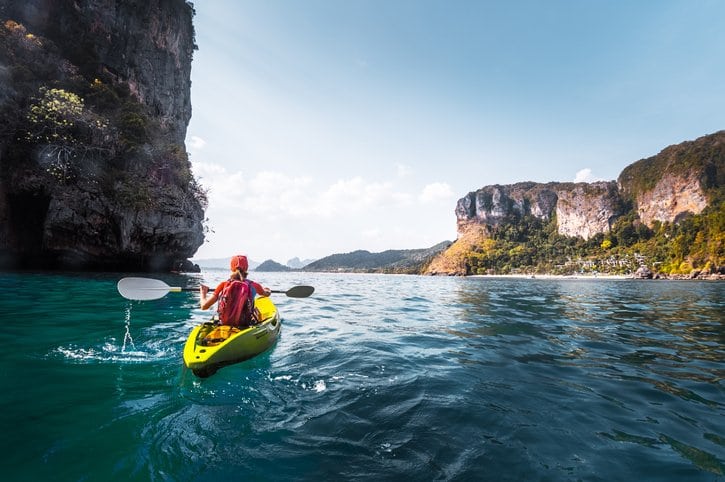For such a massive sporting and outdoor retailer, REI’s flagship store is in an interesting place. The location is the height of urbanity, sandwiched in between the interstate and Amazon’s sprawling headquarters, with the Seattle skyline’s most famous landmark visible from the corner. And yet, REI still manages to get customers in an outdoor state of mind immediately, foreshadowing an exceptional shopping experience.
The REI flagship store is inaccessible from the street. You can’t enter the store without first walking through the brand’s lush forest, almost as if you’re going on a hike before you look at hiking boots. Once you’re inside, the first thing you see is a large wooden yurt that’s decked out with a fireplace, cozy chairs and Pacific Northwest outdoor guides for customers to peruse while stoking their wanderlust.
And that’s just the beginning.
[iconstats num=”1″]
Capturing the Essence of the REI Brand
Unlike the typical apparel retailer, sporting and outdoor retailers are lifestyle brands. Buying a pair of jeans means you wear pants. On the other hand, purchasing a pair of skis says far more about you and your interests. The REI flagship captures the essence of its brand (and the people who love it) right away and maintains it throughout the 100,000 square foot store, where only about 40% is dedicated to selling products.
The majority of the flagship’s floorspace is more about selling a sense of adventure and curating experiences. REI doesn’t just sell mountain bikes; there’s also a test trail out in the makeshift woods. There are climbing shoes for sale, as well as in-store rock climbing classes where customers can learn how to use them.
[iconstats num=”2″]
There’s even… OK, there aren’t any waterways for you to test out kayaks. The REI flagship store is on the cusp of two of Seattle’s most densely populated neighborhoods, after all. But all over the REI flagships are suggestions for where customers can use their purchases, whether from the guidebooks sitting on every table, the in-store park ranger (we’ll get back to that) or the various signs sharing local tips. One example is the paddling guide that makes the reader feel like they’re getting an inside scoop. Each suggestion is complete with geographic coordinates and tidbits like which trips are good for camping or spotting sea lions.
Enhancing the Experience with Expertise
In our best practices guide for sporting and outdoor retailers, we highlighted the importance for these brands to have experts on hand. Purchases in this category naturally lend themselves to more questions from customers, compared with, say, a shirt. REI’s sales associates need to know how to size for ski boots or what to look for in a mountain bike.
Much like everything else about the REI flagship, the in-store expertise speaks less to the merchandise than how and where customers use it. And some of that expertise comes from the National Park Service, the U.S. Forest Service and Washington State Parks. The three organizations staff the store with actual park rangers. They educate people about where to take advantage of the Pacific Northwest’s abundant outdoor recreation areas and even sell the passes necessary to get in.
In addition, REI regularly hosts related classes and educational sessions, many of which are free to the public. Recent examples include where to find swimming holes in Washington, the basics of hiking safety and beginner-level bike maintenance.
The Best of Brick and Click
There’s no shortage of people to help. But one thing we like about the REI flagship is that the brand makes a point to assist customers in answering their own questions. For example, one table display featuring women’s Patagonia climbing pants includes a chart explaining the differences between four of them. One pair is designed for protection against snow, while another is airier, in order to keep the wearer cool during warm-weather activities. At first glance, these pants look identical.
[iconstats num=”3″]
The flagship includes brick and click elements, most of which are pretty simple in execution. Right by the checkout line, there’s a sign letting customers know where to pick up online orders. This saves them time and frustration, while also keeping the line more streamlined. The clothespins are another example of a small-yet-brilliant brick and click feature. If you’re browsing a rack and don’t see your size, it’s natural to check the website, though the inventory is often different. REI puts clothespins on hangers to flag the items that have more selection online, along with the appropriate URLs. That way, fewer customers will search the website, only to be disappointed when they come up empty.
While REI’s in-store experience is excellent, that’s not to say the brand hasn’t paid equal attention to digital channels. REI boasts personalized product recommendations, a suite of unique mobile apps, and a strong email preference center, just to name a few. But what makes REI stand out so much is how much they tie in with the physical shopping experiences.
